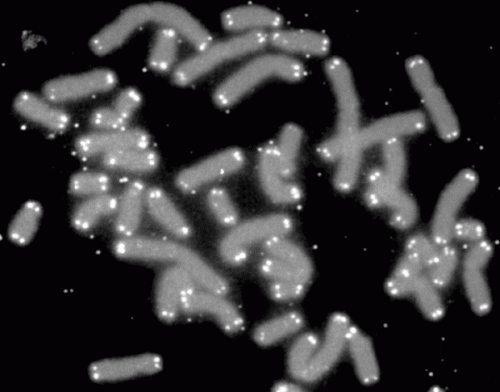Telomeres and cancer mortality: The long and the short of it

Telomeres are short stretches of repeated nucleotides that protect the ends of chromosomes. In somatic cells, these protective sequences become shorter with each cellular replication until a critical length is reached, which can trigger cell death.
In actively replicating cells such as germ cells, embryonic stem cells, and blood stem cells of the bone marrow, the enzyme telomerase replenishes these protective caps to ensure adequate replication. Cancer cells also seem to have the ability to activate telomerase, which allows them to keep dividing indefinitely, with dire consequences for the patient. However, according to a study published April 10 in the JNCI: Journal of the National Cancer Institute, the extent to which cancer cells can utilize telomerase may depend on which variants of the genes related to telomerase activity are expressed in an individual's cells.
Telomere shortening is an inevitable, age-related process, but it can also be exacerbated by lifestyle factors such as obesity and smoking. Thus, some previous studies have found an association between short telomeres and high mortality, including cancer mortality, while others have not. A possible explanation for the conflicting evidence may be that the association found between short telomeres and increased cancer mortality was correlational but other factors (age and lifestyle), not adjusted for in previous studies, were the real causes. Genetic variation in several genes associated with telomere length (TERC, TERT, OBFC1) is independent of age and lifestyle. Thus, a genetic analysis called a Mendelian randomization could eliminate some of the confounding and allow the presumably causal association of telomere length and cancer mortality to be studied.
To perform this analysis, Line Rode, M.D., Ph.D., of the Department of Clinical Biochemistry and The Copenhagen General Population Study, Herlev Hospital, Copenhagen University Hospital, Herlev, Denmark, and colleagues, used data from two prospective cohort studies, the Copenhagen City Heart Study and the Copenhagen General Population Study, including 64,637 individuals followed from 1991-2011. Participants completed a questionnaire and had a physical examination and blood drawn for biochemistry, genotyping, and telomere length assays.
For each subject, the authors had information on physical characteristics such as body mass index, blood pressure, and cholesterol measurements, as well as smoking status, alcohol consumption, physical activity, and socioeconomic variables. In addition to the measure of telomere length for each subject, three single nucleotide polymorphisms of TERC, TERT, and OBFC1 were used to construct a score for the presence of telomere shortening alleles.
A total of 7607 individuals died during the study, 2420 of cancer. Overall, as expected, decreasing telomere length as measured in leukocytes was associated with age and other variables such as BMI and smoking and with death from all causes, including cancer. Surprisingly, and in contrast, a higher genetic score for telomere shortening was associated specifically with decreased cancer mortality, but not with any other causes of death, suggesting that the slightly shorter telomeres in the cancer patients with the higher genetic score for telomere shortening might be beneficial because the uncontrolled cancer cell replication that leads to tumor progression and death is reduced.
The authors conclude, "We speculate that long telomeres may represent a survival advantage for cancer cells, allowing multiple cell divisions leading to high cancer mortality."
More information: Peripheral Blood Leukocyte Telomere Length and Mortality Among 64637 Individuals From the General Population, DOI: 10.1093/jnci/djv074


















